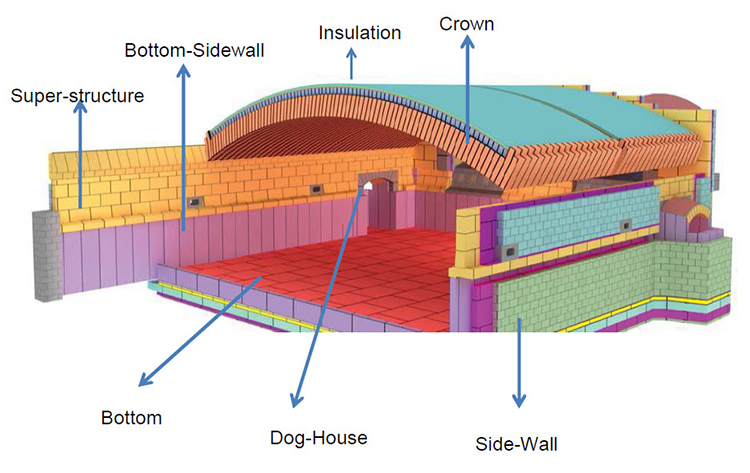Based on the operating experience of domestic and international float glass furnaces, the main measures to enhance the melting capacity of float glass furnaces can be summarized as follows: optimizing furnace dimensions, utilizing high-calorific-value fuels and efficient burners, upgrading refractory materials, implementing full furnace-width batch charging, extending the fusion zone, increasing flame coverage, increasing the number of burners, raising melting temperatures, and adopting electric boosting.

01
Optimized Furnace Dimensions
The furnace dimensions must match the desired melting capacity, particularly the width and length of the melting zone pool and their aspect ratio. A pool that is too small will restrict melting capacity, while an excessively large pool will compromise melting quality and energy efficiency.
02
High-Calorific-Value Fuels and High-Efficiency Burners
To enhance the melting capacity, it is necessary to use high-calorific-value fuels coupled with high-efficiency burners to achieve the ideal high-temperature melting effect. Melting temperature plays a critical role in determining a furnace’s melting capacity. Common high-calorific-value fuels include crude oil, liquefied petroleum gas (LPG), and natural gas.
Burner installation typically follows two methods:
(1) Internal Furnace Ignition Burners, which can be top-mounted, side-mounted, or bottom-mounted;
(2) External Furnace Ignition Burners (under-hearth type), where burners are installed outside the furnace, offering easier maintenance and replacement.
Generally, internally ignited burners offer higher efficiency than external ones but require higher investment and are less convenient for maintenance and replacement.
03
Full Furnace-Width Batch Charging
In the past, about 80% of the furnace melting pool had narrow batch feed openings. Since the batch hopper was even narrower than the feed pool, the batch distribution across the furnace width was only about 70%. This narrow feed limited the effective heating area of the flame.
By adopting full furnace-width batch charging, the batch distribution width can reach approximately 90% of the melting area, fully utilizing the flame’s heating area and significantly enhancing both the furnace’s melting capacity and the quality of the molten glass. Full-width batch charging can improve melting capacity by 8–10%.
04
Extending the Pre-Melting Zone Length
The length of the pre-melting zone is typically measured from the centerline of the small furnace to the front of the melting zone. In practice, the area beneath the L-shaped suspended wall nose is also considered part of the pre-melting zone.
A longer pre-melting zone allows the batch material to be preheated more effectively, contributing to improved melting capacity.
05
Increasing Flame Coverage
Flame coverage is defined as the percentage of the total width of all burner nozzles in the melting zone length.
Greater flame coverage results in a more uniform flame distribution, which is beneficial for the melting process.
06
Increasing the Number of Burners
When only two burners are used in the small furnace, the flame distribution inside the furnace tends to be uneven.
By installing three or more burners, the flame distribution becomes more uniform, effectively increasing the flame coverage, enhancing melting, and boosting the furnace’s melting capacity.
07
Raising the Melting Temperature
High-temperature melting significantly enhances melting capacity. It involves adopting a higher temperature curve before reaching the hot spot in the melting zone, where the peak temperature should reach 1590°C or even higher.
This must be achieved under suitable structural conditions, including optimized furnace dimensions, the use of high-calorific-value fuels, efficient burners, and high-quality refractory materials.
08
Electric Boosting
Electric boosting can increase the melting capacity by approximately 10%.
For newly constructed float glass lines, unless space constraints or other limitations exist, it is generally unnecessary to install electric boosting systems from the beginning.
Electric boosting is typically considered only after the furnace has been put into operation and it is found that the melting capacity is insufficient.
